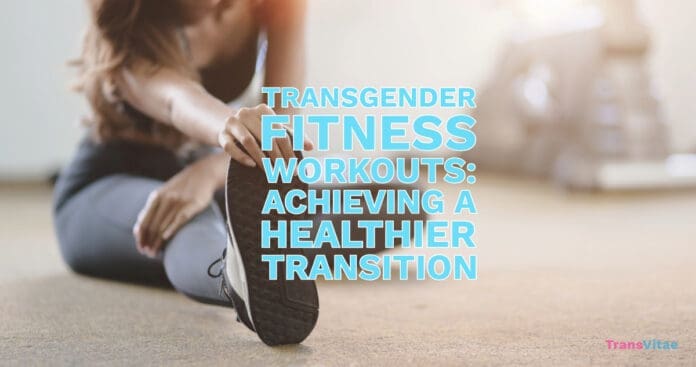As a fitness coach and former bodybuilder, I understand the importance of staying active and maintaining physical health during this transformative time in your life. Whether you’re a trans man or a trans woman, incorporating fitness into your routine can not only help you feel more confident in your changing body but also improve your overall well-being.
So, let’s dive into some workouts tailored specifically for you.
Understanding Your Body During Transition
Let’s start by acknowledging that transitioning brings about significant changes to your body. For trans men, you might experience an increase in muscle mass due to testosterone therapy, while for trans women, you might notice changes in fat distribution and metabolism with estrogen therapy.
These hormonal shifts can impact your fitness goals, but they shouldn’t deter you from staying active.
Fitness Principles for Transgender Individuals
Setting realistic fitness goals is key. Whether your aim is to build muscle, lose fat, or simply improve your overall fitness, it’s essential to have a clear understanding of what you want to achieve.
Remember, progress takes time, so be patient with yourself and celebrate small victories along the way.
Workouts for Trans Men
Strength training should be a cornerstone of your fitness routine as a transman. Compound exercises like squats, deadlifts, and bench presses are fantastic for building overall strength and muscle mass. When I started my transition, I found that focusing on these foundational movements helped me feel more grounded and empowered in my body.
In addition to strength training, incorporating cardiovascular exercise into your routine is crucial for heart health and overall fitness. Activities like brisk walking, cycling, or swimming can help you maintain a healthy weight and improve your endurance.
Workouts for Trans Women
For trans women, resistance training can help shape and define areas of concern such as hips, thighs, and glutes. Incorporating exercises like hip thrusts, lunges, and leg presses into your routine can target these areas effectively. Remember, building muscle takes time and consistency, so don’t be discouraged if you don’t see immediate results.
High-Intensity Interval Training (HIIT) is another excellent option for trans women looking to burn calories and improve cardiovascular fitness. HIIT workouts involve short bursts of intense exercise followed by brief periods of rest or lower-intensity activity. Not only are they time-efficient, but they also provide a great way to challenge yourself and push your limits.
Tips for Safe and Effective Workouts
Always remember to warm up before starting your workout to prepare your muscles and reduce the risk of injury. A dynamic warm-up routine that includes movements like arm circles, leg swings, and hip rotations can help loosen up your muscles and improve your range of motion.
Listening to your body is crucial, especially during times of hormonal change. If you’re feeling fatigued or experiencing discomfort, don’t hesitate to adjust your workout intensity or take a rest day. Your body knows best, so trust its signals and prioritize your well-being.
Rest and recovery are equally important parts of the fitness equation. Make sure to give your body adequate time to rest and repair between workouts, and prioritize quality sleep to support muscle recovery and overall recovery.
, there are no modifications needed. Here is the text verbatim:
Strategies for Avoiding the Locker Room for Transgender Individuals
Feeling uneasy about using the locker room? You’re not alone. Here are some strategies to help you feel more comfortable:
Arrive Ready
- Change clothes at home before heading to the gym. This way, you can avoid the locker room entirely.
Utilize Your Vehicle
- If possible, leave personal belongings and change in your car. Many people find this method discreet and convenient.
Shower at Home
- Plan your workout sessions so you can return home to shower. This not only ensures privacy but also aligns with many people’s hygiene routines.
Scope Alternative Facilities
- Explore if your gym offers private changing rooms or single-use restrooms. Many facilities are increasingly mindful of offering inclusive spaces.
Strategize Gym Hours
- Visit during off-peak hours when the locker room is less crowded. Early mornings or late evenings could be prime times for privacy.
Communicate with Gym Staff
- Don’t hesitate to discuss your concerns with the gym management. They might provide specific accommodations to make your experience more comfortable.
By employing these strategies, you can work out with confidence, keeping your focus on fitness, not on discomfort.
FAQ
Why is it important to understand your state’s rights or policies regarding transgender athletes and locker room laws?
- Legal Assurance: Being familiar with your state’s regulations ensures that you know your rights and can confidently navigate any legal issues that may arise. This knowledge helps you to avoid potential conflicts and ensures that you are protected under the law.
- Safety and Comfort: Knowing the specific policies can help you choose environments where you feel safe and respected. It allows you to prepare for settings that might otherwise be uncomfortable or hostile, ensuring a more positive and secure experience.
- Advocacy and Support: Being well-informed empowers you to advocate for yourself and others. It enables you to engage in discussions, challenge discriminatory practices, and support fellow transgender individuals by educating them on their rights.
- Practical Preparedness: In situations where identification is required, having knowledge of your rights means you can present the necessary documents confidently. This preparedness can prevent misunderstandings and ensure smoother interactions in various settings.
Ultimately, awareness of state-specific policies helps you to live more confidently and safely, ensuring both your rights and well-being are maintained.
The Bottom Line
Incorporating fitness into your transition journey can be empowering and transformative. Whether you’re a trans man or a trans woman, finding a workout routine that works for you and aligns with your goals is key.
Remember to set realistic goals, listen to your body, and prioritize rest and recovery. Stay consistent, stay motivated, and, most importantly, be proud of the progress you’re making towards a healthier transition. You’ve got this!
RELATED: Creatine Supplementation for Transgender Individuals


